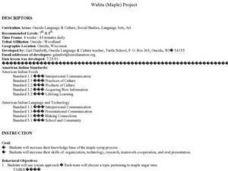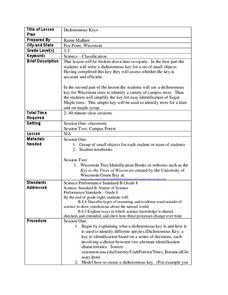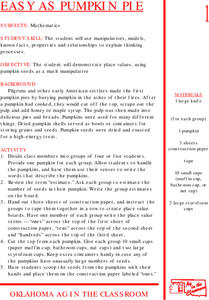Curated OER
Maple Syrup
Learners explore maple syrup. In this natural resources activity, students identify a maple tree in their neighborhood and observe the sap. Learners sample maple products and create a graph of the taste-testing results.
Curated OER
The History of Maple Syrup
Students explore the process of harvesting maple syrup. In this science and history lesson, students make their own maple syrup and create a picture book that shows the Native American and American pioneer methods of making the syrup.
Curated OER
Maple Syrup Production
Young scholars make their own maple sugar and learn about how it is made on a grander scale. In this maple sugar lesson, students make their own maple sugar and learn about evaporation and what labor is put into making it.
Curated OER
Maple Syrup
Middle schoolers comprehend the process of making pure maple syrup. They identify differences between pure syrup and artifical maple syrup. Students are asked what is in the displayed containers. They sample the syrups and try to figure...
Curated OER
Maple Syrup Production
Students examine the steps of maple sugar production and the labor and effort involved from the tree to the final product. They participate in a taste test game, and if they have access to maple trees, make their own syrup and sugar.
Curated OER
Wahta (Maple) Project
Learners increase their knowledge base of the maple syrup process and increase their skills of organization, technology, research, teamwork-cooperation, and oral presentation. Students use a team approach to choose a topic pertaining to...
Kenan Fellows
Sustainability: Learning for a Lifetime – Soil
Do great gardeners really have green thumbs—or just really great soil? Environmental scholars discover what makes Earth's soil and soil quality so important through research and experimentation. Learners also develop an understanding of...
Curated OER
Dichotomous Keys
Learners utilize dichotomous keys to identify trees in their schools. In this ecological identification lesson, students practice creating dichotomous keys based on simple subjects such as hair color or sex of a person....
Curated OER
EASY AS PUMPKIN PIE
Young scholars demonstrate place values using pumpkin seeds as a math manipulative. They use manipulatives, models, known facts, properties and relationships to explain thinking processes. They estimate the number of seeds in their pumpkin.
Curated OER
Summer Body Activity: A Nose Workout
Students have sensory experiences with the sweet smell of discovery. In this early childhood science lesson, students use their sense of smell as they create and compare their very own fragrance essences with a variety of provided...
Curated OER
Introduce Vocabulary: The Keeping Quilt
Learners consider tier two vocabulary words. In this vocabulary instructional activity, students investigate the meaning of new vocabulary words found while reading The Keeping Quilt. Learners record their new vocabulary words using a...
Curated OER
Tree Friends
Students are introduced to tree structure and use. They identify their special tree using all senses except sight. Students identify six different internal parts within a cross section of tree trunk (bark, phloem, xylem, cambium,...
Curated OER
If a tree falls in the forest.......
Students identify by-products from forests used in their everyday lives. They describe several ways in which people depend on forests. Students list everyday products made from trees, then research and categorize less common products...
Curated OER
Contributions in Society
First graders explore Canadian history by investigating the First Nations. In this Canadian heritage lesson, 1st graders identify the contributions made by the First Nations to the country of Canada. Students collaborate to create a...
Curated OER
Harve and Ester's Tree Company
Students examine the role of trees in their lives. They identify products that come from trees and their uses. They are read a book about trees as well.
















